+ Open data
Open data
- Basic information
Basic information
| Entry | Database: PDB / ID: 1hm6 | ||||||
|---|---|---|---|---|---|---|---|
| Title | X-RAY STRUCTURE OF FULL-LENGTH ANNEXIN 1 | ||||||
 Components Components | ANNEXIN 1 | ||||||
 Keywords Keywords | METAL / LIPID BINDING PROTEIN / phospholipid/Ca(2+)-binding protein / calcium-free form / full-length protein comprising protein core and N-terminal domain | ||||||
| Function / homology |  Function and homology information Function and homology informationregulation of interleukin-1 production / granulocyte chemotaxis / regulation of leukocyte migration / positive regulation of T-helper 1 cell differentiation / phospholipase A2 inhibitor activity / regulation of hormone secretion / neutrophil activation / calcium-dependent phospholipid binding / negative regulation of T-helper 2 cell differentiation / vesicle membrane ...regulation of interleukin-1 production / granulocyte chemotaxis / regulation of leukocyte migration / positive regulation of T-helper 1 cell differentiation / phospholipase A2 inhibitor activity / regulation of hormone secretion / neutrophil activation / calcium-dependent phospholipid binding / negative regulation of T-helper 2 cell differentiation / vesicle membrane / negative regulation of exocytosis / motile cilium / cellular response to glucocorticoid stimulus / positive regulation of wound healing / phosphatidylserine binding / monocyte chemotaxis / lateral plasma membrane / G protein-coupled receptor signaling pathway, coupled to cyclic nucleotide second messenger / phagocytosis / phagocytic cup / positive regulation of T cell proliferation / positive regulation of interleukin-2 production / regulation of cell shape / actin cytoskeleton organization / regulation of inflammatory response / early endosome membrane / basolateral plasma membrane / adaptive immune response / apical plasma membrane / inflammatory response / innate immune response / calcium ion binding / signal transduction / extracellular space / extracellular exosome / nucleus / plasma membrane / cytoplasm Similarity search - Function | ||||||
| Biological species |  | ||||||
| Method |  X-RAY DIFFRACTION / X-RAY DIFFRACTION /  SYNCHROTRON / SYNCHROTRON /  MIR, MIR,  MOLECULAR REPLACEMENT / Resolution: 1.8 Å MOLECULAR REPLACEMENT / Resolution: 1.8 Å | ||||||
 Authors Authors | Rosengarth, A. / Gerke, V. / Luecke, H. | ||||||
 Citation Citation |  Journal: J.Mol.Biol. / Year: 2001 Journal: J.Mol.Biol. / Year: 2001Title: X-ray structure of full-length annexin 1 and implications for membrane aggregation. Authors: Rosengarth, A. / Gerke, V. / Luecke, H. #1:  Journal: Acta Crystallogr.,Sect.D / Year: 2000 Journal: Acta Crystallogr.,Sect.D / Year: 2000Title: Crystallization and Preliminary X-ray Analysis of Full-length Annexin I Comprising the Core and N-terminal Domain. Authors: Rosengarth, A. / Luecke, H. | ||||||
| History |
| ||||||
| Remark 300 | BIOMOLECULE: 1 THIS ENTRY CONTAINS THE CRYSTALLOGRAPHIC ASYMMETRIC UNIT WHICH CONSISTS OF 2 CHAIN(S) ...BIOMOLECULE: 1 THIS ENTRY CONTAINS THE CRYSTALLOGRAPHIC ASYMMETRIC UNIT WHICH CONSISTS OF 2 CHAIN(S). THE BIOLOGICAL MOLECULE MAY BE A MONOMER OR HIGHER OLIGOMER. | ||||||
| Remark 999 | SEQUENCE Seemann et al. deposited the cDNA sequence in genbank that they obtained from a library ... SEQUENCE Seemann et al. deposited the cDNA sequence in genbank that they obtained from a library screening. However, they were not able to get the complete cDNA. Later on, they introduced the naturally occuring (but missing) 5 amino acid residues at the N-terminal domain by PCR. This is also described in their paper (Seemann et al. (1996), Mol. Biol. Cell 7, 1359-1374). According to Seemann et al. (1996), the sequence shown herein starts with residue Met1, that would be residue -5 according to the truncated genbank entry, although there was no electron density observed for this residue. The amino acid sequence does not exactly match the (DNA) sequence deposited in the genbank by Seemann et al. However, the authors received the original construct from them and the amino acid sequence is according to his paper (Seemann et al., (1996), see above) (confirmed by amino acid sequencing). The electron densities of the respective amino acid residues in the annealed omit map showed clearly that the following changes have to be made in comparison to his genbank sequence: 1) residue 51 is a Leu (not Ser) 2) residue 69 is a Leu (not His) 3) residue 231 is a Pro (not Leu) 4) residue 289 is a Ile (not Asn) |
- Structure visualization
Structure visualization
| Structure viewer | Molecule:  Molmil Molmil Jmol/JSmol Jmol/JSmol |
|---|
- Downloads & links
Downloads & links
- Download
Download
| PDBx/mmCIF format |  1hm6.cif.gz 1hm6.cif.gz | 162.7 KB | Display |  PDBx/mmCIF format PDBx/mmCIF format |
|---|---|---|---|---|
| PDB format |  pdb1hm6.ent.gz pdb1hm6.ent.gz | 127.8 KB | Display |  PDB format PDB format |
| PDBx/mmJSON format |  1hm6.json.gz 1hm6.json.gz | Tree view |  PDBx/mmJSON format PDBx/mmJSON format | |
| Others |  Other downloads Other downloads |
-Validation report
| Summary document |  1hm6_validation.pdf.gz 1hm6_validation.pdf.gz | 390 KB | Display |  wwPDB validaton report wwPDB validaton report |
|---|---|---|---|---|
| Full document |  1hm6_full_validation.pdf.gz 1hm6_full_validation.pdf.gz | 398.5 KB | Display | |
| Data in XML |  1hm6_validation.xml.gz 1hm6_validation.xml.gz | 14.9 KB | Display | |
| Data in CIF |  1hm6_validation.cif.gz 1hm6_validation.cif.gz | 26.5 KB | Display | |
| Arichive directory |  https://data.pdbj.org/pub/pdb/validation_reports/hm/1hm6 https://data.pdbj.org/pub/pdb/validation_reports/hm/1hm6 ftp://data.pdbj.org/pub/pdb/validation_reports/hm/1hm6 ftp://data.pdbj.org/pub/pdb/validation_reports/hm/1hm6 | HTTPS FTP |
-Related structure data
| Related structure data |  1ainS S: Starting model for refinement |
|---|---|
| Similar structure data |
- Links
Links
- Assembly
Assembly
| Deposited unit | 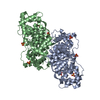
| ||||||||
|---|---|---|---|---|---|---|---|---|---|
| 1 | 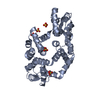
| ||||||||
| 2 | 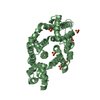
| ||||||||
| Unit cell |
|
- Components
Components
| #1: Protein | Mass: 38802.355 Da / Num. of mol.: 2 Source method: isolated from a genetically manipulated source Source: (gene. exp.)   #2: Chemical | ChemComp-SO4 / #3: Water | ChemComp-HOH / | Has protein modification | Y | |
|---|
-Experimental details
-Experiment
| Experiment | Method:  X-RAY DIFFRACTION / Number of used crystals: 1 X-RAY DIFFRACTION / Number of used crystals: 1 |
|---|
- Sample preparation
Sample preparation
| Crystal | Density Matthews: 2.52 Å3/Da / Density % sol: 51.08 % | ||||||||||||||||||||
|---|---|---|---|---|---|---|---|---|---|---|---|---|---|---|---|---|---|---|---|---|---|
| Crystal grow | Temperature: 277 K / Method: vapor diffusion, hanging drop / pH: 8.5 Details: 2.2 M Ammonium sulfate, 0.1 M Tris/HCl, pH 8.5, VAPOR DIFFUSION, HANGING DROP, temperature 277K | ||||||||||||||||||||
| Crystal grow | *PLUS Temperature: 4 ℃ / Method: vapor diffusion | ||||||||||||||||||||
| Components of the solutions | *PLUS
|
-Data collection
| Diffraction | Mean temperature: 100 K |
|---|---|
| Diffraction source | Source:  SYNCHROTRON / Site: SYNCHROTRON / Site:  ALS ALS  / Beamline: 5.0.2 / Wavelength: 1 Å / Beamline: 5.0.2 / Wavelength: 1 Å |
| Detector | Type: ADSC QUANTUM 4 / Detector: CCD / Date: Oct 28, 1999 |
| Radiation | Protocol: SINGLE WAVELENGTH / Monochromatic (M) / Laue (L): M / Scattering type: x-ray |
| Radiation wavelength | Wavelength: 1 Å / Relative weight: 1 |
| Reflection | Resolution: 1.8→40 Å / Num. all: 68225 / Num. obs: 68225 / % possible obs: 93 % / Redundancy: 10 % / Rmerge(I) obs: 0.082 / Net I/σ(I): 14.6 |
| Reflection shell | Resolution: 1.8→1.83 Å / Rmerge(I) obs: 0.599 / Mean I/σ(I) obs: 2.1 / Num. unique all: 3596 / % possible all: 99.4 |
| Reflection | *PLUS Num. measured all: 679717 |
| Reflection shell | *PLUS % possible obs: 99.4 % |
- Processing
Processing
| Software |
| ||||||||||||||||||||||||||||
|---|---|---|---|---|---|---|---|---|---|---|---|---|---|---|---|---|---|---|---|---|---|---|---|---|---|---|---|---|---|
| Refinement | Method to determine structure:  MIR, MIR,  MOLECULAR REPLACEMENT MOLECULAR REPLACEMENTStarting model: PDB entry 1AIN Resolution: 1.8→40 Å / Cross valid method: RFREE / σ(F): 0 / σ(I): 0 / Stereochemistry target values: Engh & Huber
| ||||||||||||||||||||||||||||
| Displacement parameters | Biso mean: 26.62 Å2 | ||||||||||||||||||||||||||||
| Refinement step | Cycle: LAST / Resolution: 1.8→40 Å
| ||||||||||||||||||||||||||||
| Refine LS restraints |
| ||||||||||||||||||||||||||||
| Xplor file |
| ||||||||||||||||||||||||||||
| Software | *PLUS Name: CNS / Version: 1 / Classification: refinement | ||||||||||||||||||||||||||||
| Refinement | *PLUS Lowest resolution: 40 Å / σ(F): 0 / % reflection Rfree: 5 % / Rfactor all: 0.223 | ||||||||||||||||||||||||||||
| Solvent computation | *PLUS | ||||||||||||||||||||||||||||
| Displacement parameters | *PLUS | ||||||||||||||||||||||||||||
| Refine LS restraints | *PLUS
|
 Movie
Movie Controller
Controller




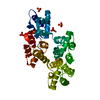
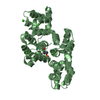

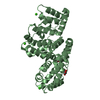
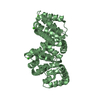
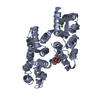

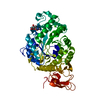
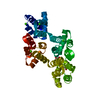
 PDBj
PDBj


